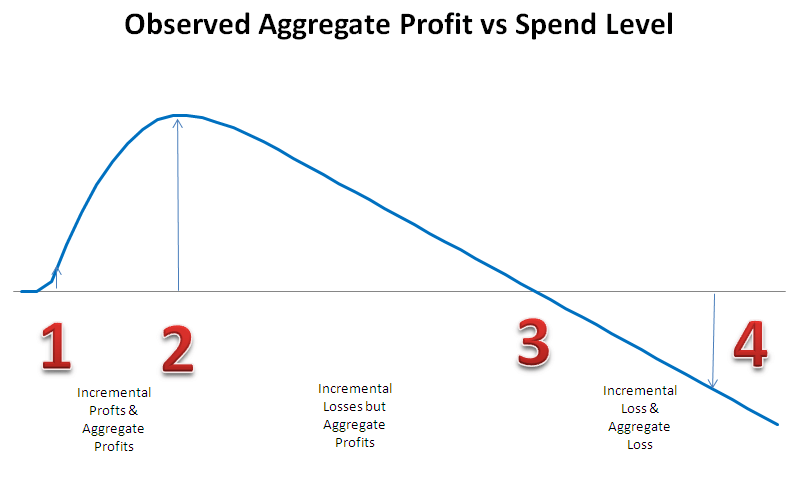How Hard Should You Press The Gas Pedal In Paid Search?
The following post contains a number of metaphors strained to the breaking point; viewer discretion is advised. An enduring truth in the paid search business is that paid search managers and marketing teams spend far more time thinking about tactical minutia than they do thinking about what are far and away the most important questions […]
The following post contains a number of metaphors strained to the breaking point; viewer discretion is advised.
An enduring truth in the paid search business is that paid search managers and marketing teams spend far more time thinking about tactical minutia than they do thinking about what are far and away the most important questions to the business:
“What is the ultimate objective of paid search for our company? And how do we measure success against that goal?”
If the goals and measurement have been thoroughly fleshed out, considered and analyzed, then it makes sense that attention be focused on the “how to” questions — but often, it seems that applying scrutiny to the goals themselves leads to changed success metrics that have far more impact on performance than any number of geeky tactical maneuvers.
Every company can articulate their goals, but sometimes scratching deeper reveals shaky rationale supporting them.
For companies that budget search spend, marketers need to ask:
- “Who determines the budget and what criteria do they use?”
- “Are these criteria the same or different than those used to determine the budgets of other marketing programs online and off?”
- “At that budget, do you expect a profitable ROI? Breakeven? Investment for long term growth? Brand exposure?”
- “Does the budget rise and fall with market opportunity or is it rigid quarter-to-quarter?”
- “How do you measure and think about the “R” in ROI?”
For companies that set efficiency targets for non-brand search and allow the advertising spend to rise and fall with opportunity, a different set of questions should follow:
- “Great! What’s the basis of that ROI constraint?”
- “How does that ROI relate to business profits? Screamingly profitable? Breakeven? Investment?”
- “How does the marginal ROI compare to your average ROI?”
- “Does your “R” factor in all relevant success metrics like cross-device, offline spillover, registries, email sign ups, catalog requests, etc.?”
- “Over what time frame do you think about getting the return: the first interaction with a customer, or is some notion of lifetime-value folded in?”
Much of this boils down to how aggressively a company can drive marketing without wrecking.
Google recently launched an initiative to help advertisers think more carefully about performance marketing objectives and asked me to do some evangelizing with them.
On June 12th, I joined a Google Hangout titled: “The Profit Playbook” to discuss this topic with Peter Fader, Professor of Marketing and Co-Director of the Wharton Customer Analytics Initiative and Billy Ferriolo, SVP of Consumer Acquisition at Autobytel which was moderated by Nicholas Darveau-Garneau, Google’s Director of Performance Marketing.
Summarizing an hour long Hangout isn’t the objective here, but I do want to flesh out some of the themes.
Maximizing Profit Vs. ROI
Nicholas says that “the best way to increase profits from your digital marketing investments is to make profits your main KPI. It seems self-evident, but very few advertisers are actually doing this.”
His point is that too often companies take as their goal maximizing ROI — a ratio — rather than maximizing profit — which is what you put in the bank at the end of the month. Increasing bids may decrease ROI as a ratio, but may drive enough additional volume to more than make up the difference.
He is right, of course. Picking only the lowest hanging fruit yields great per-piece profitability, but not much total profit. If the goal is profit maximization, then the proper approach is to first pick the lowest hanging fruit (of course) but to also pick the fruit higher up the tree as long as the value of the fruit picked is greater than the time/cost of picking it.
Let’s look at the math of diminishing marginal returns and we’ll see this clearly. As spend levels increase, efficiency inevitably decreases because we buy wisely, grabbing the most efficient opportunities first leaving less-efficient opportunities left over to choose next.
Threshold 1 on the graph represents Observed ROI Maximization. Threshold 2 represents Observed Profitability Maximization. Threshold 3 represents Return Maximization at Breakeven Profits, and Threshold 4 Represents Return Maximization at Some Investment.
Putting The Pedal To The Metal
To switch metaphors, just for fun, Nicholas sees some advertisers putting the car in drive but hardly putting any pressure on the gas pedal. They’re content to idle forward and “save money” on gas, but they don’t see the opportunity-loss associated with going so slowly.
He advocates for moving from 1 to 2:
Moving from ROI ratio maximization to short term profit maximization is an unmistakable, indeed unquestionable win.
However, many advertisers already go well beyond that. Most of our clients spend at least to observed breakeven (position 3 on the graph) on non-brand search.
The marginal ROI (slope) is negative moving from 2 to 3, but the loss is justified on the grounds that the portfolio comes in at breakeven. This allows the company to generate the maximum observed return from search at a breakeven investment overall.
But how do marketers justify going beyond position 3? At that point, not only is each conversion coming at a loss on the margin, but the collective whole is underwater, as well.
How can that ever make sense? To many smart marketers it does, and the reasons for that perspective involve some combination of the following arguments:
- We don’t see all the conversions driven by paid search. There are cross-device effects, there is spillover to brick and mortar, people drop cookies reducing the observable conversions. Factoring in this hidden value makes the additional investment wise.
- The graph above only accounts for short-term ROI. The lifetime value of the consumers engaged is more than enough to justify additional investment.
- Growing the customer base is valuable in and of itself. It leads to more customers to market to via email, direct mail, re-marketing display ads, social media, etc. This increases the natural lifetime value of a customer.
- Growth gives additional clout with vendors. Volume discounts and co-op marketing dollars go to the companies that sell more product. Publishers can charge more for advertising on site. Insurance companies can spread risk over a larger base. Bigger is better.
- Broader awareness creates more buzz, more PR, more word-of-mouth marketing, more in-bound links and social mentions. One of the most under-appreciated components of customer lifetime value is the propensity of happy customers to spread the word to their friends, which is vastly more powerful given the connective tissue of social media, Pinterest boards, etc.
- There is brand value to prominence on the SERP, and visits to website and apps. Engagement and awareness has value even if hard to measure.
- The media buyers get to spend like drunken sailors, I should be able to, as well!
Okay, I haven’t heard anyone use the last argument explicitly, but they’ve kinda hinted at it, and vastly different ROI expectations between marketing channels is a bit hard to understand.
How Far Should You Go?
Nicholas at Google is certainly right that pushing from 1 to 2 is certain to be rational. Whether moving from 2 to 3 or even into 4 makes sense may depend on the shape of the curve.
If the marginal ROI drops like a rock, it could be that the channel is effectively maxed out, either because you’re at the top of everything that matters to your brand, or your competitors are being so much more aggressive it doesn’t make sense to chase them.
However, if bidding more aggressively generates material incremental returns, consider the extent to which the arguments for 4 apply to your brand. What’s the lifetime value of a customer for you? How significant could untracked spillover be? What is the Word-of-Mouth value of a customer?
To this last point — if the answer is, “I have no idea,” consider doing this down and dirty analysis:
- Do a survey of 100 random converting new customers on your website who reached the site through a brand search or direct navigation and who had no prior interaction with other marketing channels as best you can tell.
- Ask them: “Why did you come to our site that day?”
- Tally up the fraction of these new customers who say something like ‘a friend/relative suggested I go to your site.’ Call that X. You might be startled at how large X is.
- What fraction of all customers are new customers coming in via brand search or direct load? Call that Y.
- Multiply X and Y and call that Z. Might Z represent the number of additional customers brought in by WOM of other customers? Would that materially increase the direct lifetime value a customer?
Hacky, yes — but sometime hacks are valuable enlightenment.
Whether 2 is right for you, or something more like 3 or 4, will depend on many factors. Ultimately, more aggressive advertising, into the world of untraceable effects, needs to result in a healthier P & L. If it doesn’t, maybe easing off the pedal is right.
Hope this is helpful fodder for discussion.
Drive carefully.
Stock image used with permission of Shutterstock.com
Contributing authors are invited to create content for Search Engine Land and are chosen for their expertise and contribution to the search community. Our contributors work under the oversight of the editorial staff and contributions are checked for quality and relevance to our readers. The opinions they express are their own.
Related stories




